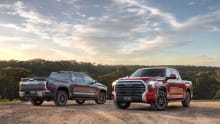
It's a truck off! 2024 Ford F-150 versus Ram 1500 spec for spec - which of these Toyota Tundra rivals is king of the road?
Full-sized US pick-ups, considered gas-guzzling monstrosities by some in our...
Browse over 9,000 car reviews

Whether you’re planning on buying an off-road SUV or ute as your family car with the intention of never leaving the paved stuff, or you have some big toys that you need to tow regularly, there are things you should be conscious of before you begin your adventure.
Firstly, if you’re not buying new and trying to save a few quid, be wary of backyard sellers. Yes, you can get some seriously cool modifications and gear (hello awnings and racking systems) but if you don’t know your stuff, it could be easy to miss mods that haven’t been installed properly.
If it’s a new vehicle, any modifications that haven’t been done by the manufacturer (or an approved fitter) can void your warranty. It can also be easy to hide cosmetic damage and any ‘quick-band aid’ repairs on bigger mechanical faults.
But if you have fallen in love with something and you’re not super cluey with mechanical stuff, take it to a reputable mechanic and get it thoroughly looked over.
When you test drive it, turn the music off and listen to the engine for rattles or weird sounds etc. And if you notice white, blue or black smoke from the exhaust, politely make your exit. All three indicate issues and you don’t need the headache.
Look at servicing logs to make sure they’ve been completed and that the car has been well-maintained.
Look at the interior and its wear and tear. Is it fair for its age? If you’re buying a ute or SUV that’s been used on a farm, don’t expect it to look amazing. Make sure you check underneath the carriage for any obvious signs of rust or damage. Also check the crevices of doors, hinges and in the bonnet for signs of neglect/ rust as this is a good indication if there are larger problems.

Dealers don’t always know the cars they’re selling best but there is usually an easier pathway for rectification or compensation if you’re sold a dud.
Another item to consider, which a lot of people don’t, are the tyres. A lot of off-roading types have muddies, which are those big chunky tyres that help the vehicle keep traction on all of their adventures. They tend to whistle and roar when you’re travelling at anything over 50km/h. They also tend to increase your fuel usage too, so if you don’t plan on going off-road, ditch them. No matter how cool they may look, they’re superfluous to your needs.
Now comes the family bit. Safety is paramount when you have kids on board. Check the ANCAP safety rating, download the report and actually read it. It’s amazing what pops up in those reports despite the car having a five-star rating! Look at the individual assessment scores, as well as the number of airbags. Comparing two utes with a five-star rating may seem like you’re doing an ‘apples for apples’ safety comparison but one might have some mid-seventy individual scores, while the other has scores in the nineties.

Can you fit your child seat in the back seat? Are there ISOFIX anchors and top tether points? Is it easy to get your kid in and out? Does the big SUV or ute have side steps/ handles to assist? Lifting your kid up into their seat every day could get annoying.
If you’re buying a ute for everyday family use, look at getting a cover for the tray. If you don’t want to go the hard top route, then at least get a tonneau cover. This is very helpful for keeping your gear dry and to not think about having to ‘cover your load’ when you’re just going on a grocery run.
The benefit of a hard tray cover is that they’re lockable and you can get racking to go on top that will hold extra gear when you need it. I also highly recommend getting some sort of soft drop assist for the tailgate, like a gas strut etc. Ute tailgates can be heavy and unwieldy to operate. They tend to smash down hard without one and you don’t want your little ones in the way when that happens!

Let’s also look at towing capabilities and tow-ball weight loads. This is where you can’t wing it. You need to know how heavy your boat/caravan and trailer combo are and that includes all the gear you are going to load inside of it! There are two capacities that manufacturers quote for towing - braked and unbraked. Unbraked means your trailer does not have brakes and, you guessed it, braked means that it does.
The average unbraked towing capacity for most vehicles is around 700 to 750kg and the average top braked capacity sits around 3500kg. Although there are some big American-style pick-up trucks that claim up to 4500kg towing capacity. If you have some hefty cargo to tow and are looking at second-hand vehicles that have that towing capacity, enquire on what the car has towed in the past and more importantly - where it has towed. Its odometre may seem low but are they hard kilometres?
Lastly, if you’re considering a ute, actually sit in the back to see how truly comfortable your kids will be. And don’t skimp out on amenities. If you’re doing towing, off-roading and long trips, then not having air conditioning, charging ports or directional air-vents in the second/third rows will be a nightmare.










Comments